Downloadable pdf for both Fruit Trees and Perennial Shrub Fruit
Perennial fruiting plants include shrubs like blueberries, currants and gooseberries, cane fruit like raspberries and blackberries, vine fruit, including kiwi vines and grapes, and herbaceous perennials like strawberries. These fruit plants are fairly quick to establish and usually start fruiting sooner than fruit trees. Like all perennial plant, get off to a good start by knowing what each kind of plant needs to thrive:
Blueberries are shallow, fibrous rooted plants. To grow well, they need:
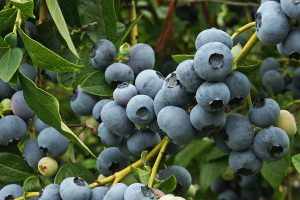
Fresh blueberries!
- Organic rich soil- work in rotted compost, sawdust (not cedar) or bark mulch to improve the soil. this is best done by amending a whole area to a depth of about 6″, rather than amending planting holes.
- NO competition from grass or weeds- keep the beds clean. These shallowly rooted plants cannot compete with other plants for water or nutrients.
- Consistent moisture- even established blueberries need summer water. Drought can stunt the plants and affect future fruit bud formation.
- Minimum of 6 hours of sun in the summer for sweet fruit. Less sun will mean later ripening and fruit that is more tart in flavor.
- Plant 3′-5′ apart for highbush varieties. Dwarf varieties can be planted closer together.
- Plant at least 2 varieties for pollination unless marked Self-Fertile. Blueberries are both wind and bee pollinated, so planting your bushes fairly close to each other (rather than on either sides of a building) can help pollination.
- Feed with a fertilizer formulated for acid loving plants. Both organic and conventional fertilizers are available for this group of plants; sometimes they are labelled for other acid loving plants such as rhododendrons. Cottonseed meal is also a good organic fertilizer for acid loving plants.
- For more information, visit the Growing Blueberries page.
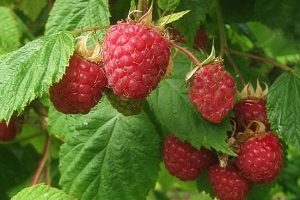
Raspberries are easy on well-drained soils
Cane Fruit: Blackberries and Raspberries
- Blackberries are tolerant of most soils, but won’t tolerate saturated winter soils.
- Raspberries need well drained soil: build raised beds if your soil is at all wet in winter. The variety Cascade Delight is more tolerant of heavier soils than some older varieties, but still needs fairly good drainage.
- Blackberries and summer raspberries need a trellis: they grow a cane one year and that cane flowers and fruits the second year. A trellis provides support for the year old canes. Fall bearing raspberries fruit on first year canes and can be grown without trellising.
- Plant raspberries and blackberries very shallowly, barely cover the roots. Planting too deeply usually leads to failure.
- Keep watered well during summer
- Cane fruit need a minimum of 6 hours of sun in summer
- See our Cane Fruit page for more detail
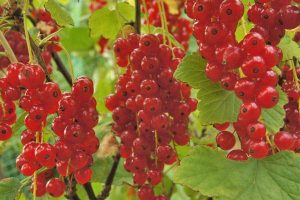
Red currants are easy to grow
- Tolerant of many soils except very wet ones.
- Tolerant of some summer shade, can fruit with as little as 4-5 hours of summer sun
- Need renewal pruning (removal/thinning) of older canes to keep fruiting
- Plant 4′-6′ apart
- Thorny gooseberry varieties and black currants are not attractive to deer.
- See our Growing gooseberries and currants page for more detail
- Need sandy, well-drained soil, amended with compost
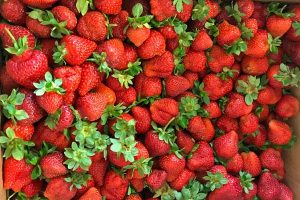
Day-neutral strawberries fruit all summer
- Keep beds well-watered in summer
- Fertilize in late summer
- Plant main crop varieties 15″-24″ apart in rows 30″-36″ apart
- Pinch all blossoms the first season to encourage root establishment
- Allow runners to fill in to create a row 18″-24″ wide by pinning runners every 6″-8″.
- Plant day-neutral (everbearing) varieties 10″-18″ apart in rows 30″-36″ apart.
- Pinch first set of blossoms to encourage roots.
- Allow 1 runner between each plant if planted on the wider spacing. Cut off all other runners
- See our strawberry growing page and handout for more detail
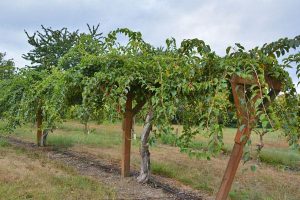
Mature kiwi vines on trellis
- Need well drained soil and summer moisture
- Need sturdy trellising
- Need 6 hours of summer sun
- Fuzzy varieties need some winter wrapping of trunks to prevent splitting
- Male cultivars are needed for pollination: 1 male per 6-8 female plants. Male must be from the same group (fuzzy, arguta) as the females as the groups bloom at different times.
- Female vines need 6′-8′ of trellis length per plant
- See our kiwi page and handout for pruning methods
- Need well drained, lean soil
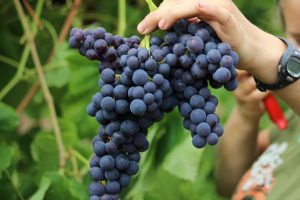
Table grapes are rewarding to grow. Make raisins with the extras!
- Need all day sun, no shade
- Need sturdy trellis support
- Are drought tolerant once established
- See our table grape and wine grape pages and handouts for pruning and training methods
